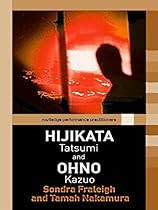

This compact; well-illustrated and clearly written book unravels the contribution of two of modern theatrersquo;s most charismatic innovators. Hijikata Tatsumi and Ohno Kazuo is the first book to combine:an account of the founding of Japanese butoh through the partnership of Hijikata and Ohno; extending to the larger story of butohs international assimilationan exploration of the impact of the social and political issues of post World War Two Japan on the aesthetic development of butohmetamorphic dance experiences that students of butoh can explorea glossary of English and Japanese terms. As a first step towards critical understanding; and as an initial exploration before going on to further; primary research; this addition to the Routledge Performance Practitioners series is unbeatable value for todays student.
#2268782 in eBooks 2006-11-22 2006-11-22File Name: B000OT8392
Review
0 of 0 people found the following review helpful. Very cogently written. Reading in on Kindle and enjoying ...By Andrew J. WaskeyVery cogently written. Reading in on Kindle and enjoying it even though art is far from my core education and interests. I appreciate the clear and earnest way that so much art about Jesus; Mary and others is presented. Well worth the small price. Plan to share with an art teacher colleague soon.5 of 5 people found the following review helpful. Great introduction to the topicBy S. Smith-PeterThis is an excellent overview of Christian art on its own terms. That is; its not about the rise of trends within art but rather about the meaning it was trying to convey. This is actually quite refreshing after reading so many art books written about influence and trends rather than meaning.The author begins by noting that she will look only at pictorial art; so no architecture or sculpture. There is very little on Orthodoxy or Eastern Christianity in general. Instead the focus is on Catholicism and Protestantism.The book begins with an introduction and starts with the earliest Christian paintings - catacomb art - that focused on the image of Christ as Good Shepherd; rather than the Crucifixion; arguing that such a focus at a time when Christians were an oppressed minority would not have been appealing.The first chapter deals with images of Virgin Mary. Williamson lists the rather scanty mentions of Mary in the Bible and notes that many pictures came from the non-canonical Golden Legend instead. The discussion of the portrayal of the Annunciation is particularly interesting. She notes that the artist can decide which stage of the event to focus on and as a result can show the announcement; Marys disbelief; or her acceptance.The second chapter deals with images of Christ; and focuses on the Crucifixion and the idea of Christ as Man of Sorrows. Through detailed analyses of specific visual works; she shows the layers of meaning and argument that are embodied in the paintings.The next chapter surveys the portrayal of saints in art. The attributes of saints often came from their lives; particularly from the Golden Legend. She discusses how contact with saints bodies was said to have healing powers and shows how this developed over time. Relics and reliquaries had magic powers. Again; by analyzing specific paintings; she shows that these were not just works of art but arguments for a particular attitude toward saints.She then turns to a discussion of images and narrative; which contrasts icons or static portrayals of figures; with narrative visuals that can provide a story. This develops the tension between iconoclasm (anti-imagery ideas that sometimes meant destroying images) and a belief that images were the best way to reach and convince the people; both illiterate and literate. Also; those that could read and write in the vernacular were different than those that could read and write Latin; and texts could reach all the groups. She analyses the cathedral at Assisi and shows that its visual argument was that St. Francis of Assisi was another Christ. This was done by juxtaposing similar types of activities of St. Francis and Christ. She discusses how the medieval mind organized the world in terms of types. So the Old Testament and the New were compared in order to find similar types.She then turns to a discussion of art in the Reformation and Counter-Reformation. The altarpiece of Martin Luthers own church in Wittenburg is analyzed as an expression of his belief that only baptism and confession (he later changed his mind of the latter) should be retained. She compares the emotionality of Caravaggio to Rembrandts restraint in the Prodigal Son; noting that the Protestant idea that grace was freely given; even if unearned; led to a more contemplative art. She then turns to a discussion of contemporary debates in art.Short with a lot of content; clearly expressed.4 of 4 people found the following review helpful. Historical context and tradition matterBy W. CheungThis book provides ample information on the history of Christian art such that the reader probably will look at Christian paintings in a different way after reading it. Constrained by its size (a mere 120 pages); It limits itself to paintings per se. In the introduction; it explains why iconodulism triumphed and in a sense delimited the nature of Christian paintings; and implicitly emphasized the importance and continuity of tradition. For instance; the Hodegetria essentially is the prototype of all subsequent Madonna and Child. The author skilfully links various genres with doctrinal development. Examples given include the dogma of the Immaculate Conception; the doctrine of transubstantiation; and the process of canonization. All these led quite directly to a burgeoning of different forms of paintings like the altarpiece and devotional images. The impacts of the Reformation and Counter-Reformation on style are very well discussed; using works of Caravaggio; Cranach; Holbein; Rubens; and Rembrandt to illustrate. The book also includes a chapter on the relationship between text and images. The final chapter on contemporary art is surprisingly informative. Five stars.